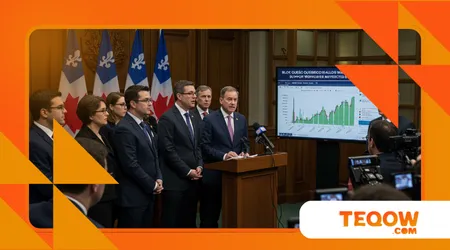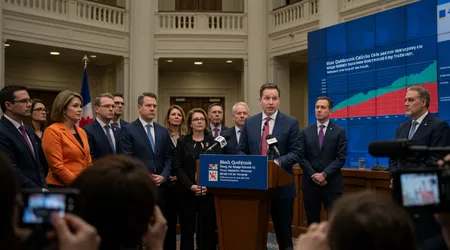Bloc Québécois Calls for Wage Subsidy to Support Workers Affected by Trade War

The subsidy to support workers affected by trade war proposed by the Bloc Québécois has ignited a vital conversation in Canada’s economic landscape.
As U.S. tariffs under President Donald Trump’s trade policies ripple across borders, Quebec’s workers face mounting uncertainty.
The Bloc’s bold plan aims to shield vulnerable employees, particularly in manufacturing and agriculture, from the fallout of this escalating trade war.
This article dives into the proposal’s nuances, its potential to stabilize livelihoods, and why it matters for Canada’s future.
With a federal election looming on April 28, 2025, the stakes couldn’t be higher. Can a targeted wage subsidy truly soften the blow of global trade tensions?
The trade war, fueled by Trump’s aggressive tariff regime, threatens Canada’s export-driven economy. Quebec, with its robust manufacturing and agricultural sectors, is especially exposed.
The Bloc Québécois, led by Yves-François Blanchet, has positioned itself as a defender of provincial interests, advocating for policies that prioritize local workers.
Their call for a subsidy to support workers affected by trade war reflects a pragmatic response to an unpredictable economic climate.
This initiative isn’t just about short-term relief; it’s a strategic move to bolster Quebec’s resilience amid global uncertainty.
Why the Wage Subsidy Matters Now
Canada’s economy is bracing for turbulence. Trump’s tariffs, including a proposed 25% levy on Canadian goods, could disrupt supply chains and inflate costs.
The International Monetary Fund projects U.S. economic growth to slow to 1.8% in 2025, partly due to these trade policies, with ripple effects on Canada.
Quebec’s manufacturing sector, which employs over 450,000 workers, faces risks as exports to the U.S. decline.
The subsidy to support workers affected by trade war aims to stabilize incomes for those hit hardest.
Consider Marie, a factory worker in Drummondville. Her plant, which exports auto parts to the U.S., is slashing shifts due to tariff-induced demand drops.
A wage subsidy could ensure she keeps her job, covering payroll gaps for her employer. This isn’t just financial aid; it’s a lifeline for families facing sudden income loss.
The Bloc’s proposal draws inspiration from COVID-19-era subsidies, which preserved millions of jobs. Why shouldn’t we adapt that model to today’s trade crisis?
++ Complete Guide to GST/HST Tax Credits for 2025: Who Qualifies and How to Apply
The urgency is palpable. Polls show Quebec voters are rallying behind policies that protect local interests, with the Bloc polling at 30% in recent Abacus Data surveys.
The subsidy to support workers affected by trade war aligns with this sentiment, offering tangible relief.
It’s a proactive step to prevent layoffs and maintain economic stability in a province where separatist roots still influence political priorities.

A Strategic Response to Economic Disruption
The Bloc’s plan isn’t a blanket handout. It targets sectors like dairy, aerospace, and automotive, which are vital to Quebec’s economy.
By funneling funds to employers, the subsidy to support workers affected by trade war encourages businesses to retain staff despite market volatility.
This mirrors successful European models, where wage subsidies cushioned workers during economic shocks. Canada’s own pandemic response proved the concept works why not refine it now?
Also read: A Complete Guide to Healthcare Benefits in Canada
Picture a dairy farmer in Saguenay, struggling as U.S. tariffs choke export markets. A subsidy could cover labor costs, letting her keep her team intact.
This precision matters. The Bloc’s costed platform, released on April 19, 2025, allocates $22 billion over five years for the subsidy to support workers affected by trade war.
That’s a hefty commitment, but it’s dwarfed by the potential economic losses if inaction prevails.
Critics argue the subsidy risks bloating deficits. Yet, the cost of unemployment social benefits, lost tax revenue, and eroded consumer spending is far steeper.
The Bloc’s approach balances fiscal responsibility with human impact. It’s not about charity; it’s about preserving the economic engine that powers Quebec.
The subsidy to support workers affected by trade war could be the difference between resilience and recession.
Read more: NDP Unveils Northern Platform: A Roadmap for Healthcare, Affordability, and Infrastructure
Protecting Quebec’s Economic Identity
Quebec’s economy is distinct, rooted in cultural and linguistic pride.
The Bloc’s subsidy proposal reflects this, prioritizing local purchasing and supply management.
Their platform includes a bill to reserve Canadian content in federal contracts, akin to the U.S. Buy American Act.
The subsidy to support workers affected by trade war complements this, ensuring workers in Quebec’s heartland aren’t collateral damage in a global trade spat.
The trade war’s impact is already visible. American Airlines withdrew its 2025 forecast due to tariff-related uncertainties, signaling broader market jitters.
Quebec’s aerospace sector, a global leader, faces similar pressures. A subsidy could stabilize jobs at firms like Bombardier, preserving expertise that takes decades to build.
Isn’t it worth investing in people who define Quebec’s economic edge?
Moreover, the subsidy addresses equity. Rural workers, often overlooked in national policy, stand to benefit most.
The Bloc’s focus on farmers and small manufacturers ensures no one is left behind. This isn’t just economics it’s about honoring Quebec’s social fabric.
The subsidy to support workers affected by trade war is a statement: Quebec will not bend to external pressures.
Challenges and Criticisms of the Proposal
No policy is without flaws. The Bloc’s subsidy plan faces scrutiny over funding and implementation. Critics question how $22 billion will be sourced without hiking taxes or cutting services.
The federal deficit, already projected to persist until 2029, looms large. Will the subsidy to support workers affected by trade war strain Canada’s fiscal health?
Logistics pose another hurdle. Identifying eligible workers and businesses requires robust oversight to prevent abuse.
The Canada Emergency Wage Subsidy faced criticism for funds flowing to profitable firms can the Bloc avoid similar pitfalls? Transparency and accountability will be non-negotiable.
The proposal’s success hinges on execution, not just intent.
Then there’s the political angle. The Bloc’s separatist leanings make some Canadians wary. Opponents argue the subsidy prioritizes Quebec over national unity.
Yet, with tariffs threatening all provinces, a targeted approach could set a precedent for broader relief.
The subsidy to support workers affected by trade war might just bridge regional divides, not deepen them.
A Broader Vision for Resilience
The Bloc’s subsidy is part of a larger economic vision. Their platform includes $15 billion for public transit, boosting local jobs.
By pairing wage subsidies with infrastructure investment, they aim to create a virtuous cycle of employment and growth.
This holistic approach sets the subsidy to support workers affected by trade war apart from stopgap measures.
Think of it like a dam holding back floodwaters. The subsidy stabilizes jobs, while transit investments channel economic energy into communities.
Together, they protect Quebec from the trade war’s deluge. The Bloc’s foresight here is notable few parties blend immediate relief with long-term planning so seamlessly.
Voter sentiment underscores the plan’s appeal. The Bloc’s surge in polls reflects Quebecers’ desire for pragmatic leadership.
As Trump’s tariffs loom, the subsidy to support workers affected by trade war offers a shield. It’s not just policy; it’s a promise to prioritize people over politics.
The Road Ahead: Can It Work?
Implementing the subsidy won’t be easy. The federal government must navigate bureaucratic red tape and interprovincial tensions.
Yet, the Bloc’s track record cooperating with Liberals during the pandemic suggests they can build coalitions.
The subsidy to support workers affected by trade war could become a bipartisan rallying point.
Timing is critical. With the election days away, voters are watching. A strong Bloc showing could pressure other parties to adopt similar measures.
The subsidy’s $22 billion price tag is steep, but so is the cost of inaction. Canada’s economic future hangs in the balance.
| Key Metrics of Bloc Québécois Wage Subsidy Proposal | Details |
|---|---|
| Total Funding Allocated | $22 billion over 5 years |
| Target Sectors | Manufacturing, Agriculture, Aerospace |
| Inspiration | COVID-19 Wage Subsidy Program |
| Additional Platform Commitment | $15 billion for public transit |
| Source | Bloc Québécois Costed Platform, April 19, 2025 |
Conclusion: A Call to Action
The Bloc Québécois’ subsidy to support workers affected by trade war is more than a policy it’s a lifeline for Quebec’s workers.
As Trump’s tariffs threaten livelihoods, this $22 billion plan offers hope, targeting vulnerable sectors with precision.
It’s not perfect, but it’s bold, practical, and rooted in Quebec’s unique identity. The election on April 28, 2025, will test voters’ faith in such measures.
Will Canada rise to meet this challenge?
The Bloc’s proposal is a clarion call to protect workers, preserve jobs, and build a resilient future. Let’s not let global trade wars dictate our destiny let’s choose action.
Frequently Asked Questions
1. Who qualifies for the wage subsidy?
Workers in tariff-impacted sectors like manufacturing and agriculture, with employers proving financial strain, are eligible. Details await federal approval.
2. How will the subsidy be funded?
The Bloc proposes $22 billion over five years, likely through federal budgets, though specifics on revenue sources remain under debate.
3. Can other provinces benefit?
While Quebec-focused, the model could inspire national programs if adopted post-election, depending on political will.
4. What’s the timeline for implementation?
If passed post-election, rollout could begin in late 2025, pending legislative and administrative setup.
5. How does this differ from past subsidies?
Unlike the broader COVID-19 subsidy, this targets trade war impacts, with stricter sector-specific criteria to ensure relevance.
